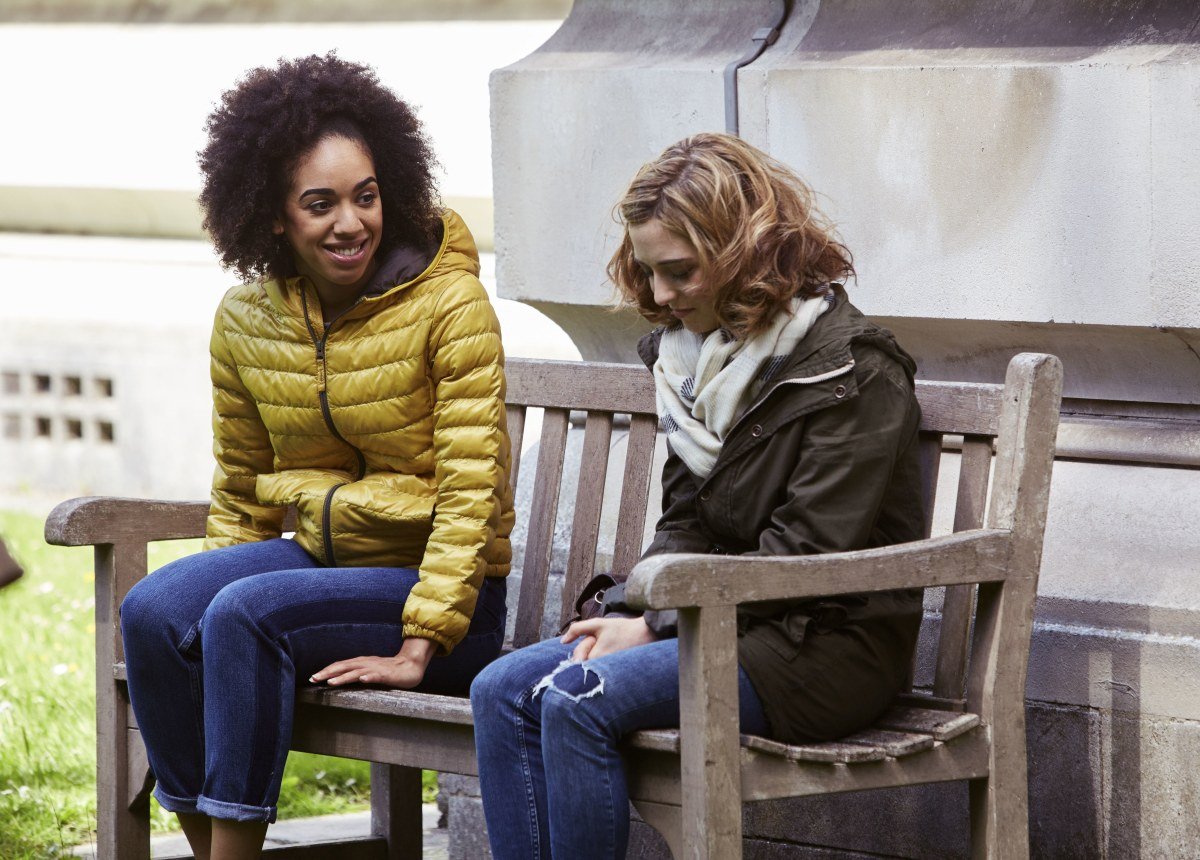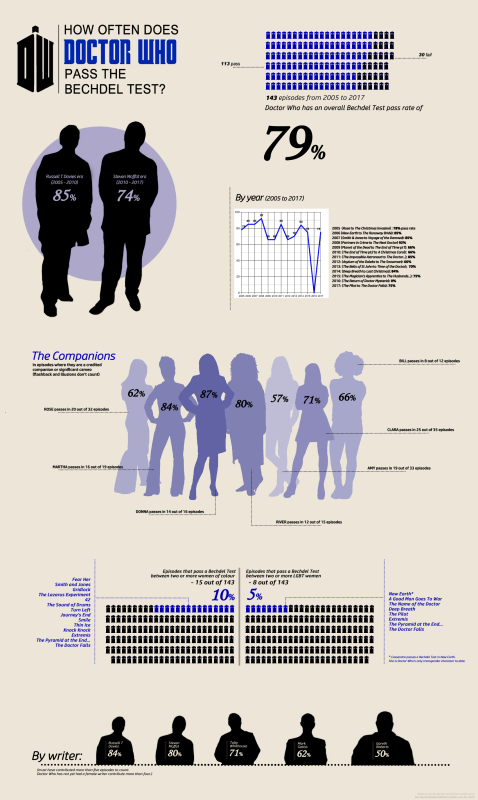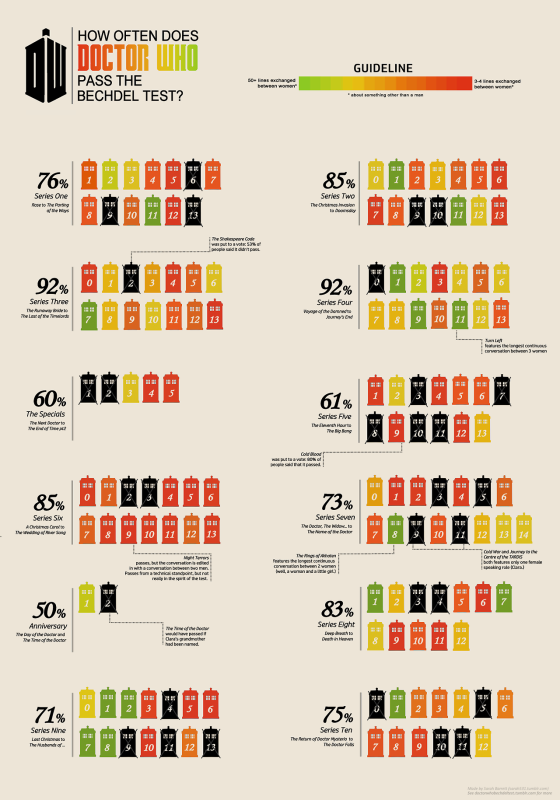If you were really heavily invested in Doctor Who a couple of years ago, maybe you ran across the Doctor Who Bechdel Test Study. Basically, its aim was to watch every single episode of modern-day Doctor Who and see how many times it passed the Bechdel Test. Are there at least two named female characters and do they talk to each other about something other than a man? The test was created by Alison Bechdel in her comic strip Dykes to Watch Out For back in 1985 (she credits her friend Liz Wallace with co-creating the idea) and it’s a very low bar that even now a lot of Hollywood movies can’t quite step over.
It was interesting to see how many times Doctor Who could do just that. But here are some thoughts I’ve picked up over the years that this study has been in progress.
The Bechdel Test doesn’t tell you if a TV show is sexist, or if it’s progressive, or if the writers behind it respected their female characters, or if anyone involved in its making is or isn’t a feminist. It is, however, very good indeed at determining whether or not two female characters speak to each other about something other than a man, and it’s in that spirit that this study was conducted. There’s lots of amazing episodes across Who’s 100+ episode run that don’t pass the Bechdel Test, and that doesn’t necessarily in any way diminish what they have to say.
“You can have a feminist movie that doesn’t meet the criteria. And you can have a movie that meets the criteria and isn’t feminist. So, it’s not scientific or anything. It was meant as a joke, but I still think it’s a very useful joke. It’s a bit surprising what does and doesn’t pass.”
What this study’s really looking for is patterns. Who’s writing the episodes where women talk frequently? Which female characters have the most conversations and/or relationships with other female characters? If an episode passes the test, does it do so on a technicality or is it because a writer made a concentrated effort to write more than one important female character and have them interact? These infographics, hopefully, present all that information for you:
If you compare them to 2015’s statistics, some interesting things have happened. The overall pass rate has gone down by 1%, but–suddenly, women of color and LGBT women are talking a bit more! Two years ago, women of color spoke to each other in only 7% of episodes, and now it’s 10%. And LGBT women speak to each other in 5% of episodes now, up from 4%. These are not remotely good statistics, not really, but clearly something’s happened to improve them slightly.
That something was likely the introduction of Bill Potts, the first black lesbian—and second black woman, and first gay woman—to ever be a co-lead on the show! (Hopefully, Alison Bechdel would approve.) Her presence immediately sent those percentages shooting up a few notches, which just goes to show that if you make your female characters sufficiently interesting, Bechdel Test passes will happen naturally. Bill’s conversations with her girlfriends, friends and crushes ensure episodes pass the Bechdel Test even if Bill herself doesn’t have a tremendous impact on the plot (see Extremis, for example). Her run on the show has been fantastic, and I really hope she ends up somehow sticking around after the showrunner change next year.
There’s something else that might happen next year, of course. The Doctor’s vacancy needs to be filled, and there’s an increasingly high chance that a woman might fill it. If we end up with a female Doctor and female companion, suddenly there’ll be even more exciting conversations between women happening on our screens. I’m very much looking forward to that.
Some final quick thoughts on the statistics and the study:
- This would have been much, much harder to do without help from the followers of the Doctor Who Bechdel Test blog, who have been fantastic about going through my maths and highlighting things I’d missed.
- I really, really wanted to count Ashildr—2015’s immortal Viking lady played by Maisie Williams—among the LGBT characters. Her dialogue seems to imply she’s attracted to Clara, and both Sarah Dollard (Face the Raven writer) and Jenna Coleman (who plays Clara) have tweeted things to imply that they hope the characters started dating after their exit. But unlike River and Clara, she never gets an actual line to confirm she’s attracted to women, so unfortunately, I had to leave her off.
- Some of these episodes would have passed the Bechdel Test easily had they just had one small change. The Time of the Doctor would have passed if Clara’s grandmother had had a name. And as Tumblr user Mewiet—who was indescribably helpful at going through all the scripts—pointed out, The Husbands of River Song would have easily passed if any of the other characters beyond the title one had been female. But they weren’t, which is a shame, especially as that was River’s sendoff episode.
- Doctor Who has gotten better at creating interesting, non-stereotypical disabled characters since the last study. In Under the Lake/Before the Flood we were given Cass, a deaf woman played by a deaf actress, and in The Pyramid at the End of the World we have Erica, a little person who is a scientist and serves as that episode’s “everywoman.” There’s still never been an episode where two disabled women talk, but I thought that was worth pointing out.
Hopefully I’ll see you all in another few years with some more data!
(image: BBC)
Sarah Barrett is a blogger, writer, and hopeless geek who got into fandom at age twelve and never quite returned to the real world. She lives, works, and writes on Tumblr.
Want more stories like this? Become a subscriber and support the site!
—The Mary Sue has a strict comment policy that forbids, but is not limited to, personal insults toward anyone, hate speech, and trolling.—











Published: Jul 12, 2017 04:13 pm